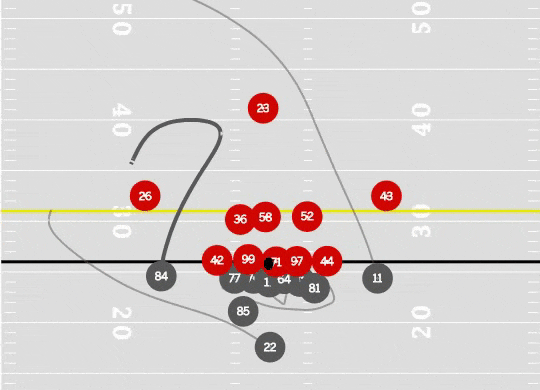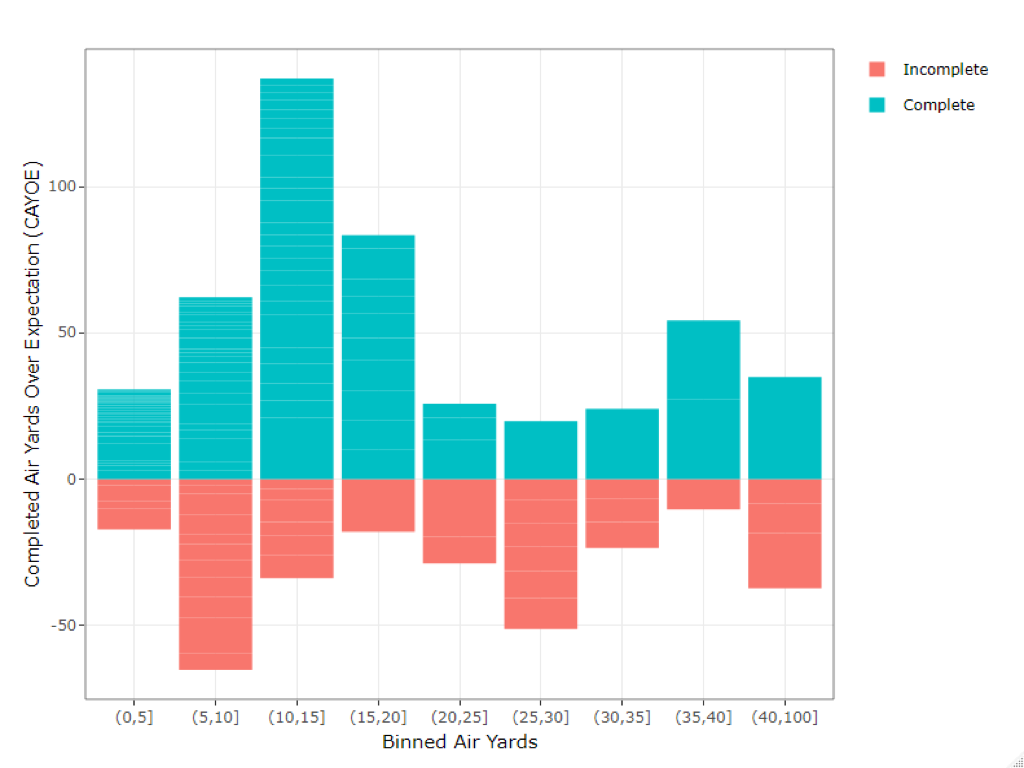Football's shiniest new metric for measuring quarterback play has a favorite signal-caller: Ryan Tannehill. And it's not even that close.
Just a couple of months removed from riding the Tennessee Titans' bench behind Marcus Mariota, Tannehill now leads the league in completion percentage over expectation (CPOE), a measure of accuracy that accounts for the difficulty of passes attempted, from NFL Next Gen Stats.
After years of poor production in Miami, Tannehill has broken out in his first season in Nashville, catching the eye of analytics junkies and mainstream football fans alike -- and his 9.8 yards per attempt leads the league. Along the way, he has brought the 8-5 Titans back into playoff contention, as they face the Houston Texans this weekend for the AFC South division lead.
Still, as well as Tannehill has performed in the CPOE metric, not every measure of success is as clear-cut on the former NFL draft first-rounder's breakout. Let's try to make sense of his season and figure out what Tennessee ought to do about the 2020 free agent for the future.
Case for | Case against | What's next
The case for Tannehill's greatness
On every play, Next Gen Stats determines expected completion percentage based on a variety of factors such as the air yards of the pass, whether the quarterback was under pressure and the receiver's separation from defenders and the sideline. A full explanation of the model can be found here.
This season, the expected completion percentage on Tannehill's 203 throws is 63.4%. His actual completion percentage? 73.4%. That 10-point differential is his CPOE, the best in the league. In fact, it's actually the best of any quarterback since 2016, when Next Gen Stats was introduced.
This is a much better metric for measuring accuracy than traditional completion percentage, which has more than a few weaknesses in its ability to evaluate overall quarterback play.
So where is Tannehill having his success? He has found a sweet spot from 8 to 20 yards, where he has completed 49 of 60 passes (77.8%); an average quarterback would be expected to complete only 60%.
In this example below, with animation from Next Gen Stats, the pass to Corey Davis carries a 33% chance of a completion because of how Tannehill is pressured and the fact Davis has almost no separation. The veteran QB completes it anyway.

One thing to keep in mind with CPOE: Like nearly all quarterback statistics, it's a reflection of a combination of skill between the quarterback and his receivers. But with Tannehill, we have a convenient data point for additional context: Mariota's CPOE with the same team. And it wasn't pretty. His CPOE was minus-2.6% this season, in the company of other underperformers such as Jacoby Brissett and Andy Dalton.
Should we have seen this coming from Tannehill? I don't think so. In 2016, Tannehill actually recorded 5% in CPOE, but in 2018 -- he missed 2017 due to injury -- he fell to minus-1%. The 11-point year-over-year improvement by Tannehill is the largest by any quarterback in CPOE's young history, and again, that's not close.
One issue with CPOE is that while depth of target is factored into the expectation, it isn't factored into the value. In other words, consider that Drew Brees and Russell Wilson both have 5% CPOEs this season, but Wilson is averaging passes that are 3 yards further downfield. Wilson's 5% is worth more overall.
To account for this we can simply multiply the CPOE by the air yards on every pass beyond the line of scrimmage. If a 10-yard pass has a 60% of completion and is caught, the QB is credited with plus-4 completed air yards over expectation (CAYOE). If it goes incomplete, he's debited 6 CAYOE. If CPOE is a measure of accuracy, CAYOE is the value of that accuracy.
Until this past weekend, Tannehill trailed Wilson and Kirk Cousins in CAYOE per attempt -- a product of the Tennessee QB excelling in short and midrange.
But then Sunday happened, when Tannehill absolutely wrecked the Raiders. His performance included a 39-air yard pass to A.J. Brown with a 31% completion probability that ultimately went for a 91-yard touchdown. And now Tannehill leads CAYOE/A, too. He's averaging over an entire completed air yard more per pass attempt than an average quarterback.
The plot below shows the quantity of air yards credited and debited to Tannehill within each air-yard range. It shows not only that Tannehill is performing well on a per-play basis in the midrange, but how much of his value has come there:

The sum of completed air yards over expectation by depth of target for Ryan Tannehill this season. The blue area is positive CAYOE on completions, while the red is negative CAYOE on incompletions. The lines within each bar designate individual pass attempts. Data via NFL Next Gen Stats.
The case against Tannehill's greatness
Before we paint Tannehill as the next Tom Brady, we need to look at the other side, too. And if you're wondering how Tannehill is managing to put all sorts of all-star numbers together while still sitting at 13th in Total QBR, it's because there is a part of his game that remains a major weakness: He takes too many sacks. Tannehill has been sacked on 10.1% of his dropbacks, the most by any qualifying quarterback in 2019.
To no surprise, he has the worst expected points added per dropback due to sacks of any quarterback. For what it's worth, Mariota was taking sacks at an even higher 12.8% rate, but Tannehill also led the league in sack rate in 2018.
The Titans actually rank ninth in Pass Block Win Rate (PBWR) this season, which for Tannehill is a big step up from the 23rd-ranked Miami unit he had in front of him last season. We've found previously that pass blocking matters, so it's reasonable to assign at least some of the credit for Tannehill's huge season to the offensive line -- though metrics such as CPOE and QBR both incorporate whether a quarterback is under pressure at time of throw to some degree.
The Titans' PBWR was actually better overall in the games Mariota started than the ones Tannehill has, though they are red-hot now: Over its past three games, Tennessee has recorded a PBWR of 82%, which is not only first in that span, but also the highest three-game stretch for any team this season. Tannehill has recorded double-digit CPOE games in those three contests.
Two more reasons Tannehill's season needs proper context:
A large percentage of his expected points added, relative to other quarterbacks, has come when Tennessee's win probability is high enough or low enough that Total QBR is significantly down-weighting that production.
Tannehill also has the benefit of playing in a system with a little more play-action, which is a good thing. He has run play-action on 30% of his dropbacks this season vs. 23% last season.
What does Tennessee do with Tannehill now?
And now we get to the tough question. It's great for Tennessee that Tannehill is playing well and could lead them to the playoffs. But when he hits the open market this offseason, they'll be left with a choice hinging on whether it's possible, at age 31, that this breakout is for real. Will this success continue?
We've mostly focused on Tannehill's play this season here. But we also have a lot more information on him. From 2012 to '18, Tannehill recorded a QBR of 49. That ranks 35th of 41 quarterbacks who qualify in that time period. Calling him mediocre prior to this season would probably be a misnomer. There have been occasional flashes, but in aggregate, for a starter, he's been bad. It seems rash not to weigh the years of data prior to this season in favor of a half-season of excellence.
And yet, this sudden burst of effectiveness has come along with a change of team. Perhaps a change in offense and life away from that miserable Dolphins offensive line was all he needed. We can't rule out the possibility the breakout is legitimate.
Pro Football Focus' Timo Riske found that a slightly different version of CPOE was found to have roughly the same linear correlation to a quarterback's next season EPA/P as EPA/P itself. Additionally, The Athletic's Ben Baldwin found that adding CPOE to EPA/P in a composite metric helped predict next season EPA/P.
Anecdotally, there are no great comparisons to Tannehill's CPOE improvement. Perhaps the best is Cousins from 2017-18, when he moved from Washington to Minnesota and increased his CPOE by nearly 5%. In 2019, Cousins has stepped it up by a couple more points. Mitchell Trubisky made a slightly larger jump from 2017-18 in CPOE -- but it was on the same team, and he has regressed in 2019.
So what should Titans general manager Jon Robinson do with this information? He has to weigh three options: Let Tannehill go and sign elsewhere, slap the franchise tag on him or sign him to a long-term deal. The first hardly seems like a good option, assuming Tannehill keeps up this level of play, because Tennessee would be left without a quarterback and the draft pick used to acquire him. Whatever placeholder it finds on the open market probably would have less upside than Tannehill.
The third option has potential value. If Tannehill is indeed a top-10 quarterback, then the Titans would presumably be locking him up for a below-market price while there's still uncertainty about his prospects. However, it also comes with substantial risk. The organization would be tethering itself to a quarterback who has a long history of poor play, even if he has played well in a Titans uniform.
The franchise tag, though, is the best option. The Titans can pay a hefty one-year price tag for the right to find out what they've got in Tannehill, without a long-term contract. With the tag, they can still pursue other QB options in the draft at the same time. This is the choice that makes the most sense. Tannehill has played well enough to entertain the possibility they have found something while keeping a healthy amount of skepticism about his actual prospects.

